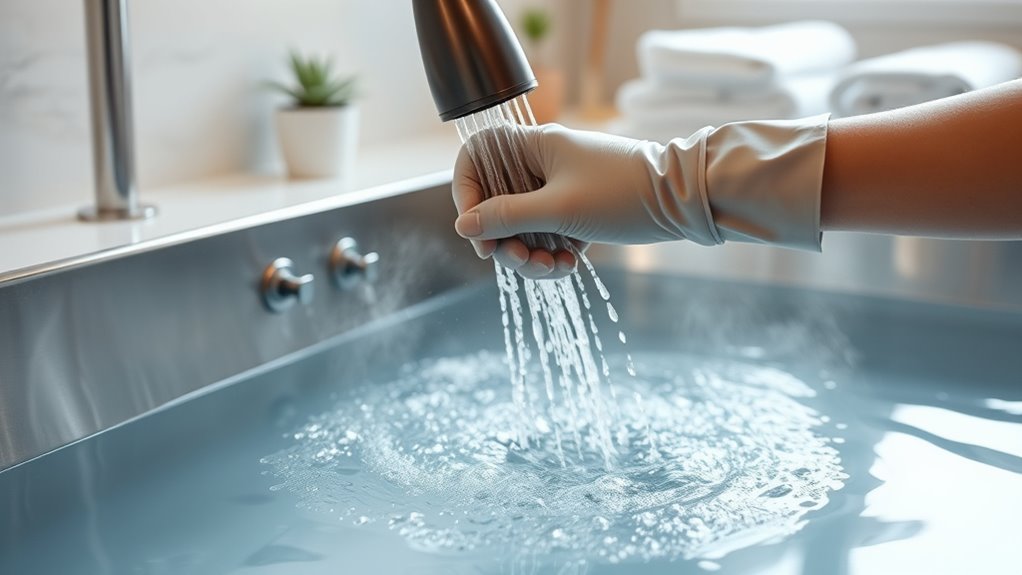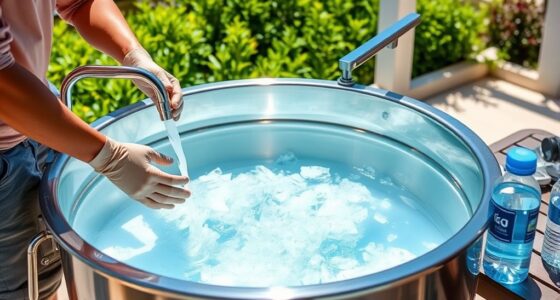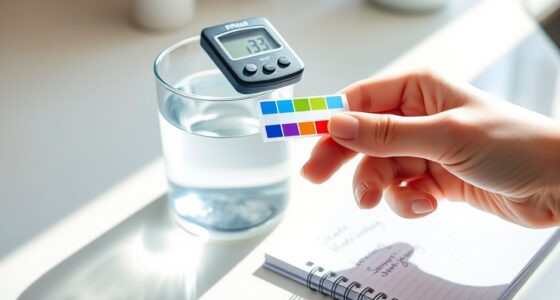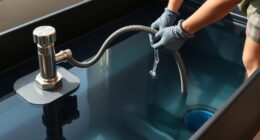To keep your cold plunge water clean, always rinse and shower before use. This helps wash away dirt, oils, sweat, and lotions that can contaminate the water. Using warm water and gentle cleansers guarantees your skin is clear of impurities that might feed bacteria or algae. Additionally, rinse thoroughly to remove any soap or product residues. Proper pre-showering and rinsing are your first line of defense—discover how to optimize this process for the best water quality.
Key Takeaways
- Proper pre-showering removes dirt, oils, and sweat, minimizing contaminants entering the water.
- Rinsing thoroughly eliminates soap and body oils that could otherwise pollute the plunge.
- Avoiding heavy lotions or oily products prevents buildup and reduces bacterial growth in the water.
- Using warm water and gentle cleansers ensures effective skin cleansing without introducing additional contaminants.
- Incorporating water filtration systems further reduces sediments and bacteria, maintaining water quality and clarity.
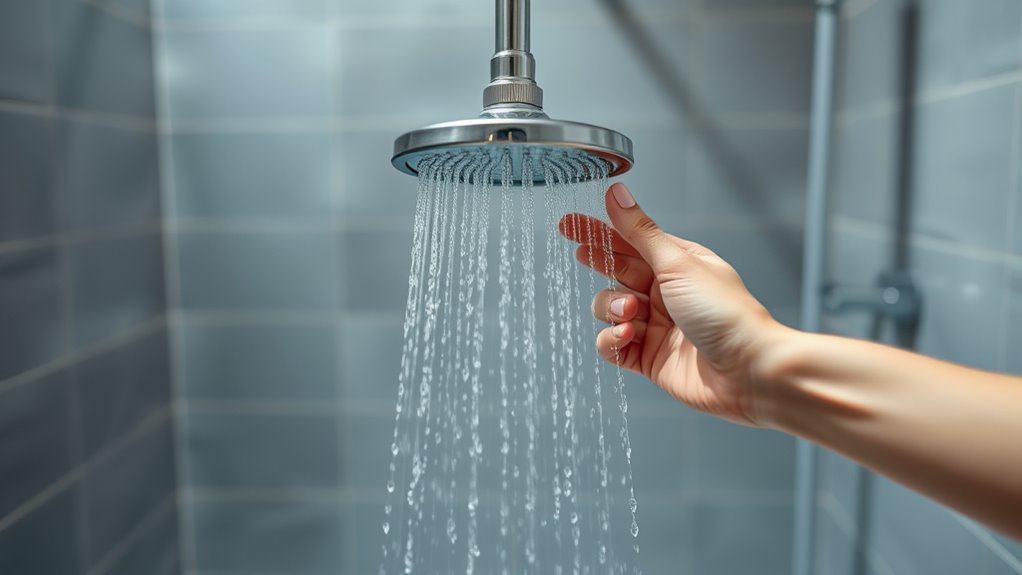
Pre-showering and rinsing are essential steps in maintaining a clean and hygienic environment, whether you’re preparing for a shower or cleaning surfaces. When it comes to protecting your cold plunge water from contaminants, these initial steps are crucial. They serve as a first line of defense by reducing the amount of dirt, oils, and impurities that can enter your water system. Proper pre-showering ensures that you’re not introducing unnecessary debris, which can compromise water quality and increase the frequency of maintenance. Rinsing thoroughly before immersing yourself minimizes the transfer of external contaminants, helping keep your cold plunge water fresh and clean over time. A key aspect of this process involves water filtration. Before you step into the plunge, consider using a filtration system to further purify incoming water. Water filtration removes sediments, bacteria, and other unwanted particles that could degrade water quality or pose health risks. By filtering the water before use, you markedly reduce the chances of introducing contaminants, preserving the clarity and safety of your cold plunge. This step not only benefits the water’s cleanliness but also extends the lifespan of your filtration equipment, making maintenance easier and less frequent. Skin cleansing is equally important during pre-showering. When you wash your skin thoroughly before entering the cold plunge, you eliminate oils, lotions, sweat, and dirt that can carry bacteria or other contaminants. This process ensures that your skin is as clean as possible, which is essential for maintaining hygienic water conditions. Proper skin cleansing also helps prevent the buildup of organic matter that could feed bacteria or algae growth in your water, ultimately keeping your cold plunge healthier and more inviting. To optimize your pre-showering routine, use warm water combined with gentle, skin-friendly cleansers. Focus on areas prone to sweat or dirt accumulation, such as underarms, groin, and feet. Rinse thoroughly to remove all residues of soap or body oils, which can otherwise contaminate your cold plunge. Avoid using heavy lotions or oily products before entering, as they tend to cling to the skin and can transfer into the water, creating a breeding ground for bacteria. Incorporating proper water filtration into your routine further enhances water quality and reduces maintenance needs. In essence, pre-showering and rinsing set the foundation for maintaining pristine cold plunge water. Incorporating effective water filtration and prioritizing skin cleansing ensures you’re not only protecting your health but also prolonging the quality and usability of your water. These simple, proactive steps make a notable difference, reducing contamination risks and helping you enjoy a clean, invigorating plunge every time.
Frequently Asked Questions
How Often Should I Rinse Before Using the Cold Plunge?
You should rinse and shower for about 2-3 minutes before using the cold plunge. This short shower helps with skin cleansing and removes sweat, oils, and dirt that can contaminate the water. A thorough rinse guarantees you’re clean without wasting too much water. Keep in mind, the goal is to reduce contaminants while maintaining efficiency, so a quick, effective shower is best before jumping into your cold plunge.
Can Soap Residues Affect Cold Plunge Water Quality?
Soap residue buildup can definitely affect your cold plunge water quality, as it can introduce chemicals and contaminants. If you don’t rinse thoroughly, shower water bacteria might cling to your skin and transfer into the plunge pool. To keep the water clean, make sure you rinse off well and avoid using heavy soap or lotions right before plunging. This way, you reduce the risk of bacteria and soap residue affecting your water.
What’s the Ideal Temperature for Pre-Showering?
Think of it like a sweet spot—you want your pre-shower water temperature to be comfortably warm, around 100-105°F (37-40°C). Keep your shower duration short, about 2-3 minutes, to avoid sweating and contamination. This way, you effectively rinse off sweat, oils, and residues without overexposing yourself. A balanced temperature guarantees you’re clean without risking transferring impurities into your cold plunge, maintaining ideal water quality.
Are There Specific Products Recommended for Pre-Showering?
You should use pre-shower products with recommended formulations that suit your skin type and effectively remove dirt and oils before your plunge. Look for gentle cleansers, body washes with antibacterial properties, or natural options like tea tree oil. Avoid harsh chemicals. These products help minimize contaminants, keeping your cold plunge water cleaner and safer. Always choose formulations that are easy to rinse off and compatible with your skin for the best results.
How Do I Prevent Water Cross-Contamination Between Showers and Plunge?
Think of your shower and plunge as a guarded fortress. To prevent waterborne pathogens from sneaking in, always rinse off thoroughly before plunging, removing any dirt or oils that could carry contaminants. Use surface disinfectants on your shower surfaces regularly to keep germs at bay. Never reuse dirty towels, and consider installing separate drainage systems if possible. These steps act as your shield, maintaining a clean, safe cold plunge experience.
Conclusion
Just as a knight prepares for battle by armor and shield, taking time to rinse and pre-shower shields your cold plunge from unwanted contaminants. By doing so, you’re not just maintaining pristine water—you’re honoring the ritual of renewal and respect for the experience. Remember, the purity of your plunge reflects your commitment to wellness. So, keep your defenses strong, and let your cold water journey be as legendary as the stories of old.
